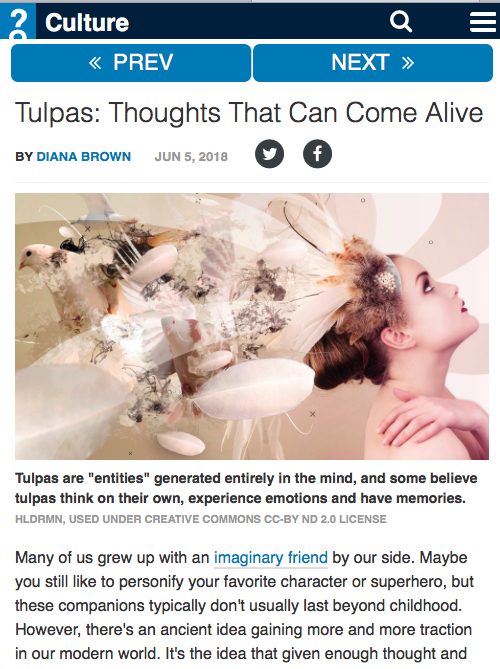
HowStuffWorks article
Tulpas Are Not Imaginary Friends
In June 2018, Howstuffworks published an article about tulpas written by Diana Brown. The article includes a link to a podcast called Stuff They Don’t Want You to Knowhosted by Ben Bowlin, Noel Brown, and Matt Frederick. [Content warning on the article and podcast episode: stigmatization, harmful movie tropes related to plurality, misinformation about tulpamancy.]
Diana Brown’s article mainly re-hashes subjects brought up within the podcast. Imaginary friends and tulpas are compared and contrasted. She mentions the Buddhist Alexandra David-Neel who had created a tulpa “…that grew more and more sinister until it eventually had to be destroyed.“ The statement “Evil tulpa” is a common stigmatization, even today. The differences between modern tulpamancy and Buddhist tulpas (sprulpas) are not defined, which makes it unclear which type of tulpamancy Diana is writing about.
Diana explains what a tulpa is in very unclear terms: “…beings or objects that are created in someone’s imagination by visualization techniques.” This may be confusing to a reader who is not well informed about tulpas.
The accompanying podcast, Stuff They Don’t Want You to Know, does little to clarify all of this confusion. The show’s hosts start out with a joke, calling Matt Frederick, “our i-Matt-ginary friend.” They briefly talk about imaginary friends. Co-host Ben Bowlin goes on to quote another Howstuffworks article titled, “How Imaginary Friends Work”:
Gleason says she once heard about a child who formed a close relationship with a can of tomato paste, for instance [source: Groskin].
Noel and Ben begin to talk about this. Noel jokingly says that the larger cans of tomato paste would seem “too aggressive” which leads to a series of joking comments. The hosts talk about movie tropes around imaginary friends. Noel brings up “multiple personality” as a trope in movies and condemns it’s use as “lazy.” When the hosts begin to discuss Tulpas, they don’t mention any research or any websites about modern tulpamancy. Nor do they define the difference between modern tulpamancy and Buddhist tulpas.
Both the article and its linked podcast are without proper research, the author and hosts seem unaware of the modern tulpamancy community, and unaware the difference between buddhist tulpas and modern tulpamancy. The hosts of the podcasts neglect to take the subject seriously; by extension making it seem ridiculous to the listener.
Article authored and donated by Hyacinth of The Sapphic Bouquet. See their blog here.
